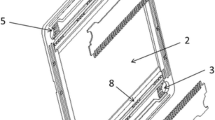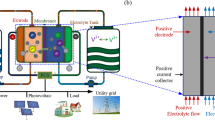Abstract
In this paper we deal with strategic considerations in designing the stack of a vanadium redox flow battery. The design of the stacks is complicated by the presence of a number of parameters that can influence the performance. For a given stack power, the cell size and the number of cells are inversely related. As the cell size increases, concerns arise over uniform circulation of electrolyte over the cell and the pressure drop incurred in circulating a larger flow rate over a longer flow path. In the present paper, these issues have been studied experimentally and through model estimates. A short stack of four cells has been prepared by connecting them in series electrically and its electrochemical performance, including pressure drop, has been characterized over a range of important design parameters. It is shown that, for the same local electrochemical performance, increasing the cell size increases the gravimetric and volumetric efficiency of the stack. Although the cell pressure drop increases with increasing cell size, the pressure drop in the manifold is reduced as there are fewer number of channels. This leads to a decrease in the parasitic power consumption for electrolyte circulation. For large-powered stacks, further reduction in pressure drop can be achieved by making deeper grooves in the serpentine channels.







Similar content being viewed by others
References
Bartolozzi M (1989) Development of redox flow batteries: a historical bibliography. J Power Sources 27:219–234
Bhattarai A, Wai N, Schweiss R, Whitehead A, Lim TM, Hng HH (2017) Advanced porous electrodes with flow channels for vanadium redox flow battery. J Power Sources 341:83–90
de Leon CP, Frias-Ferrer A, Gonzalez-Garcia J, Szanto DA, Walsh FC (2006) Redox flow cells for energy conversion. J Power Sources 160:716–732
Latha TJ, Jayanti S (2014a) Ex-situ experimental studies on serpentine flow field design for redox flow battery systems. J Power Sources 248:140–146
Latha TJ, Jayanti S (2014b) Hydrodynamic analysis of flow fields for redox flow battery applications. J Appl Electrochem 44(9):995–1006
Kumar S, Jayanti S (2016a) Effect of flow field on the performance of all vanadium redox flow battery. J Power Sources 307:782–787
Kumar S, Jayanti S (2016b) high energy efficiency with low pressure drop configurations for an all vanadium redox flow battery. J Electrochem Energy Convers 13(4):41005
Kumar S, Jayanti S (2017) Effect of electrode intrusion on pressure drop and electrochemical performance of an all-vanadium redox flow battery. J Power Sources 360:548–558
Li Ming-Jia, Zhao Wei, Chen Xi, Tao Wen-Quan (2017a) Economic analysis of a new class of vanadium redox-flow battery for medium- and large-scale energy storage in commercial applications with renewable energy. Appl Therm Eng 114:802–814
Li Yifeng, Zhang Xinan, Bao Jie, Skyllas-Kazacos Maria (2017b) Studies on optimal charging conditions for vanadium redox flow batteries. J Energy Storage 11:191–199
Ma Xiangkun, Zhang Huamin, Sun Chenxi, Zoub Yi, Zhang Tao (2012) An optimal strategy of electrolyte flow rate for vanadium redox flow battery. J Power Sources 203:153–158
Skyllas-Kazacos M, Chakrabarti MH, Hajimolana SA, Mjalli FS, Saleem M (2011) Progress in flow battery research and development. J Electrochem Soc 158:R55–R79
Tang Ao, Bao Jie, Skyllas-Kazacos Maria (2014) Studies on pressure losses and flow rate optimization in vanadium redox flow battery. J Power Sources 248:154–162
Xing Feng, Zhang Huamin, Ma Xiangkun (2011) Shunt current loss of the vanadium redox flow battery. J Power Sources 196:10753–10757
Ye Qiang, Jing Hu, Cheng Ping, Madesign Zhiqi (2015) Design trade-offs among shunt current, pumping loss and compactness in the piping system of a multi-stack vanadium flow batter. J Power Sources 296:352–364
You X, Ye Q, Cheng P (2016) Scale-up of high power density redox flow batteries by introducing interdigitated flow fields. Int Commun Heat Mass Transfer 75:7–12
Acknowledgement
Funding received from MHRD, India, Grant Ref No. F.NO.41-2/2015-T.S.-I (Pt.).
Author information
Authors and Affiliations
Corresponding author
Rights and permissions
About this article
Cite this article
Gundlapalli, R., Kumar, S. & Jayanti, S. Stack Design Considerations for Vanadium Redox Flow Battery. INAE Lett 3, 149–157 (2018). https://doi.org/10.1007/s41403-018-0044-1
Received:
Accepted:
Published:
Issue Date:
DOI: https://doi.org/10.1007/s41403-018-0044-1




